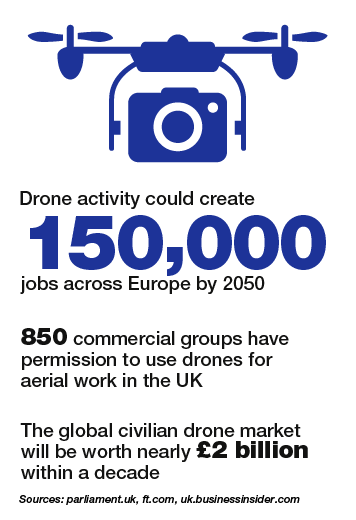Drones: What SMEs need to know
We look at the risks and opportunities aerial drones could create for SMEs.
Business Insider UK has predicted the value of the global non-military drone market will reach nearly £2 billion within the next decade and that agriculture, energy, construction and news media are among the industries paving the way.
Amazon recently called for a separate airspace zone for commercial drones and the UK Civil Aviation Authority says more than 850 commercial groups have been granted permission to conduct aerial work using drones. Experts also predict drones could create 150,000 jobs across Europe by 2050. Statistics like these demonstrate why the emergence of drones is something that SMEs should be aware of.
Technological advances
Zurich's latest SME Risk Index found only 2% of SMEs expect to use drones within the next 12 months. This picture could, however, change rapidly, partly due to technological advances that are making drones cheaper and easier to operate.
Most drones now weigh less than 20kgs and cost under £200. There will have to be regulatory change for the commercial advantages of drones to be fully realised, as in the UK, drones can only be flown within the visual line of sight of the person in charge of the vehicle.
Commercial demand, however, is likely to increase pressure on regulators to relax these rules. As the usage of drones grows, brokers have a crucial role to play in helping their SME customers understand the potential impact they could have on their businesses.
Operational risks
There are a number of operational risks SMEs should be aware of before using drones. For example, there have been media reports about near misses between drones and commercial aircrafts, and an incident in California in which firefighters tackling a wildfire were forced to ground their helicopters amid fears there could be a collision with drones.

Last year, a Cumbrian man became the first person in the UK to be convicted of "dangerously" flying an unmanned aerial vehicle, after his drone flew over a nuclear submarine testing facility.
He claimed he lost radio contact with the drone and was therefore unable to control it. To mitigate the operational hazards of drones, SMEs must ensure:
- They are aware of the rules and regulations surrounding their use. These can vary depending on the weight of the drone (see the Civil Aviation Authority's guidance for more details).
- They understand how to operate their drone safely. Some newer drones allow users to specify a geo-fence area, reducing the chance of inexperienced pilots losing control and flying their drones into people or buildings.
- They have taken out appropriate insurance. CAA rules specify minimum levels of cover required.
SMEs should be aware of the insurance implications of drones, such as: liability for accidents and injuries or damage to property, personal accident cover for injuries to employees, and legal claims for breach of privacy.
More efficient deliveries
SMEs using drones could benefit from quicker and cheaper deliveries. For example, it is estimated the cost-per-mile of an average diesel truck is more than 30 times that of a drone.
Amazon has also launched a development centre in the UK for Prime Air - a service that promises to deliver packages within 30 minutes once regulatory hurdles have been cleared.
The SMEs who are quickest to realise the benefits of these advances in technology could establish a clear advantage over their competitors. Conversely, SMEs who do not use drones may find themselves left behind, and this competitive gap could widen as the range of tasks that drones are capable of performing grows. For example, while commercial use of drones is currently centred on faster deliveries and improved surveillance and photography, some construction firms are now using drones to produce 3D models and interactive maps of job sites.
Photography
A growing number of SMEs are using drones to take aerial pictures and video footage, with drones proving particularly popular for wedding and sports photography. Estate agents are also using footage from drones to provide a new way of marketing properties.
Any SME considering using drones for commercial purposes must be aware of the requirement to obtain permission from the Civil Aviation Authority (CAA). The CAA, however, says it is aware of a number of incidents in which businesses have risked a substantial fine by using drones without the relevant permission.
Using drones for photography also carries the risk of breach of privacy, as the vantage point they offer means they are more likely to inadvertently capture images of individuals. The Information Commissioner's Office has detailed guidance on how drone operators can minimise privacy risks, such as unintentionally capturing images of children. Although SMEs may not be considering using drones in the near future, they should still be aware of the opportunities and potential risks they bring.
Brokers should take the opportunity to help their SME customers understand the impact it may have on them if drones are used at any point in their supply chain.
For more information please speak with your local Zurich contact.



